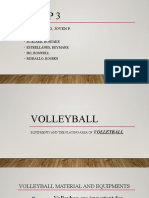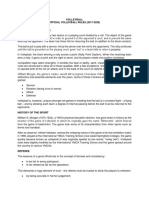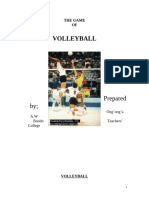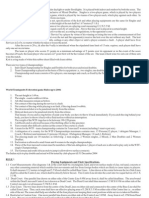Lesson 2 Pe 12 14 Volleyball
Lesson 2 Pe 12 14 Volleyball
Uploaded by
malenabmykaelafaithCopyright:
Available Formats
Lesson 2 Pe 12 14 Volleyball
Lesson 2 Pe 12 14 Volleyball
Uploaded by
malenabmykaelafaithOriginal Title
Copyright
Available Formats
Share this document
Did you find this document useful?
Is this content inappropriate?
Copyright:
Available Formats
Lesson 2 Pe 12 14 Volleyball
Lesson 2 Pe 12 14 Volleyball
Uploaded by
malenabmykaelafaithCopyright:
Available Formats
Republic of the Philippines
Cagayan State University
CARIG CAMPUS
PHYSICAL ACTIVITY AND
SPORTS TOWARD HEALTH
AND FITNESS: PE 12
Module 1 – Lesson 2
Volleyball
College of Human Kinetics
1| PHYSICAL ACTIVITY AND SPORTS TOWARD HEALTH AND FITNESS: PE 12
LESSON 2:
The Equipment and Facilities
Learning objectives:
At the end of the lesson, the students should be able to:
A. identify the different equipment and facilities used in playing volleyball;
B. differentiate the measurements of the equipment and facilities in volleyball;
and;
C. recognize the significance of proper equipment setup in ensuring a safe and
fair game.
Sporting equipment, also called sporting goods, has various forms depending on the
sport, but it is essential to complete the sport. The equipment ranges from balls, to nets, and
to protective gear like helmets. Sporting equipment can be used as protective gear or as tool
used to help the athletes play the sport.
EQUIPMENT AND FACILITIES IN VOLLEYBALL
1. The Playing Area
The playing area includes the playing court and the free zone. It shall be rectangular
and symmetrical.
The playing court is a rectangle measuring 18 x 9 m, surrounded by a free zone which
is a minimum of 3 m wide on all sides. The free playing space is the space above the playing
area which is free from any obstructions. The free playing space shall measure a minimum of
7 m in height from the playing surface.
1.1 Lines in the Court
All lines are 5 cm wide. They must be of a light color which is different from the
color of the floor and from any other lines.
BOUNDARY LINES. Two side lines and two end lines mark the playing court. Both
side lines and end lines are drawn inside the dimensions of the playing court.
CENTRE LINE. The axis of the center line divides the playing court into two equal
courts measuring 9 x 9 m each; however, the entire width of the line is considered to belong
to both courts equally. This line extends beneath the net from sideline to side line.
ATTACK LINE. On each court, an attack line, whose rear edge is drawn 3 m back
from the axis of the center line, marks the front zone.
2| PHYSICAL ACTIVITY AND SPORTS TOWARD HEALTH AND FITNESS: PE 12
1.2 ZONES AND AREAS
FRONT ZONE. Each court the front zone is limited by the axis of the centre line and
the rear edge of the attack line. The front zone is considered to extend beyond the side lines to
the end of the free zone.
SERVICE ZONE. The service zone is a 9 m wide area behind each end line. It is
laterally limited by two short lines, each 15 cm long, drawn 20 cm behind the end line as an
extension of the side lines. Both short lines are included in the width of the service zone.
SUBSTITUTION ZONE. The substitution zone is limited by the extension of both
attack lines up to the scorer's table.
LIBERO REPLACEMENT ZONE. The Libero Replacement zone is part of the
free zone on the side of the team benches, limited by the extension of the attack line up to the
end line.
WARM-UP AREA. The warm-up areas, sized approximately 3 x 3 m, are in both of
the bench side corners, outside the free zone.
3| PHYSICAL ACTIVITY AND SPORTS TOWARD HEALTH AND FITNESS: PE 12
4| PHYSICAL ACTIVITY AND SPORTS TOWARD HEALTH AND FITNESS: PE 12
DIMENSIONS OF PLAYING EQUIPMENT
The Ball
Volleyballs have a diameter of 8.15”-8.39” (20.7-21.3 cm) and circumference of
22.59”-26.34” (65-67 cm). The mass of a Volleyball is between 9-10 oz (260-280 g) with a
pressure between 4.26-4.61 psi (29.4-31.8 kPa). Volleyball has a sphere form and has 18
rectangular panels that are made of synthetic or genuine leather. The panels are arranged in 6
identical sections of 3 panels each. The Volleyball has a valve that allows its internal air
pressure to be adjusted is available. Synthetic leather material and colour combinations of balls
used in international official competitions should comply with FIVB standards.
The Net
Volleyball nets span the entire width of the court (29’6” | 9 m) and are held rigid by
outer poles typically set 3’ (.91 m) from the court. The center height of a volleyball net differs
for men’s and women’s play with men’s nets regulated at a height of 7’ 11.69” (2.43 m) and
women’s at 7’ 4.35” (2.24 m). The dimensions of the playing court are often identified on the
net surface by two antenna extending 32” (80 cm) above the net. Volleyball nets have a surface
height of 39” (1 m) from top to bottom and are constructed with a polypropylene or nylon
netting with a mesh size of 3.9” (10 cm) and are capped with stiff headbands along the
perimeters.
5| PHYSICAL ACTIVITY AND SPORTS TOWARD HEALTH AND FITNESS: PE 12
The Court
Volleyball courts are regulated at 59’ (18 m) in length with a width of 29.5' (9 m). Attack
lines dividing the front and back rows are marked 9’10” (3 m) parallel to the net. Free zones at
a minimum of 9’10” (3 m) are required around the entirety of the court with generous
clearances up to 16’5” (5 m) on the sides and 21’4” (6.5 m) in the back.
The Side Bands
Two white bands are fastened vertically to the net and placed directly above each
sideline. They are 5 cm wide and 1 m long and are considered as part of the net.
The Antennae
An antenna is a flexible rod, 1.80 m long and 10 mm in diameter, made of fiberglass or
similar material. An antenna is fastened at the outer edge of each side band. The antennae are
placed on opposite sides of the net. The top 80 cm of each antenna extends above the net and
is marked with 10 cm stripes of contrasting color, preferably red and white. The antennae are
considered as part of the net and laterally delimit the crossing space.
6| PHYSICAL ACTIVITY AND SPORTS TOWARD HEALTH AND FITNESS: PE 12
References:
https://www.dimensions.com/element/volleyball
https://www.dimensions.com/element/volleyball-courts
https://www.dimensions.com/element/volleyball-nets
7| PHYSICAL ACTIVITY AND SPORTS TOWARD HEALTH AND FITNESS: PE 12
You might also like
- 12th Pe Record BookDocument34 pages12th Pe Record Bookvedantrakholiya9No ratings yet
- Volleyball's Court SizesDocument3 pagesVolleyball's Court SizesJai Seng100% (1)
- at This Point, Badminton Was Just A Game Played For Fun, and It Was Known As "Battledore and Shuttlecock" in British India Instead of BadmintonDocument3 pagesat This Point, Badminton Was Just A Game Played For Fun, and It Was Known As "Battledore and Shuttlecock" in British India Instead of Badmintonlavender kaye75% (8)
- GluteBuilder Fitness ToolDocument2 pagesGluteBuilder Fitness ToolngranadosgNo ratings yet
- Topic 2 VolleyballDocument13 pagesTopic 2 VolleyballDee PaisenNo ratings yet
- Gpe 4 - Module 3 - VolleyballDocument37 pagesGpe 4 - Module 3 - VolleyballLorrie Mae LicayanNo ratings yet
- The History of VolleyballDocument5 pagesThe History of VolleyballTrisha MenesesNo ratings yet
- Volleyball Module Final-1Document29 pagesVolleyball Module Final-1Xyrene Kate BalisacanNo ratings yet
- Pe Unit 2Document29 pagesPe Unit 2Christine LachicaNo ratings yet
- Spec 116 Pe Team Sports VolleyballDocument2 pagesSpec 116 Pe Team Sports VolleyballKrahNo ratings yet
- Officiating and Tournament ManagementDocument35 pagesOfficiating and Tournament ManagementErica G LucasNo ratings yet
- FACILITIES AND EQUIPMENT (PANUNCIO and GALVEZ)Document7 pagesFACILITIES AND EQUIPMENT (PANUNCIO and GALVEZ)Ariana Athena V. PanuncioNo ratings yet
- Pathfit What You ThinkDocument6 pagesPathfit What You ThinkShyra OnacinNo ratings yet
- 12th Pe Record BookDocument37 pages12th Pe Record Bookrekhashah5886No ratings yet
- Facilities and EquipmentDocument6 pagesFacilities and Equipmentnicole.galvezNo ratings yet
- Volleyball Team SportsDocument188 pagesVolleyball Team SportsDinaNo ratings yet
- TOPEWORDDocument28 pagesTOPEWORDDonald Montano Dela TorreNo ratings yet
- Facilities and EquipmentsDocument23 pagesFacilities and Equipmentsmaan gasmenNo ratings yet
- Volleyball Training CenterDocument50 pagesVolleyball Training CenterEckelle Grace MagalayNo ratings yet
- "Volleyball": History and DevelopmentDocument13 pages"Volleyball": History and Developmentsamm yuuNo ratings yet
- Pe2-Activity-Quiz Grade 11 Second SemesterDocument7 pagesPe2-Activity-Quiz Grade 11 Second SemesterAlexa BarbinNo ratings yet
- Volleyball Equiments and MaterialsDocument22 pagesVolleyball Equiments and MaterialsJennifer LacdaoNo ratings yet
- Dimension CourtsDocument7 pagesDimension CourtsRen MariNo ratings yet
- Unit 1 History and Development of Volley The Facility and EquipmentDocument9 pagesUnit 1 History and Development of Volley The Facility and EquipmentMeredith MendozaNo ratings yet
- Local Media2818722997623982001Document14 pagesLocal Media2818722997623982001Joyce MingoNo ratings yet
- Facilities and EquipmentDocument33 pagesFacilities and Equipmentsharlinecatuday08No ratings yet
- Sir Jed's Final OutputDocument16 pagesSir Jed's Final OutputJessica Mariz LacandazoNo ratings yet
- Futsal PeraturanDocument37 pagesFutsal PeraturanRasyizan B RejabNo ratings yet
- Futsal LOTG 2006 enDocument72 pagesFutsal LOTG 2006 enHasan MuktiNo ratings yet
- Volleyball: History, Foundation, Facilities and EquipmentDocument81 pagesVolleyball: History, Foundation, Facilities and EquipmentAngel Amerie LorenianaNo ratings yet
- Volleyball - Facilities & EquipmentsDocument12 pagesVolleyball - Facilities & EquipmentsXDNo ratings yet
- Volleyball Eq P.EDocument32 pagesVolleyball Eq P.EJoven BèljãnóNo ratings yet
- Facilities & Equipment Used in Volleyball ?Document4 pagesFacilities & Equipment Used in Volleyball ?marigoldNo ratings yet
- Volleyball: Rules and Regulations: Group 2Document189 pagesVolleyball: Rules and Regulations: Group 2Kristle AlbinoNo ratings yet
- VolleyballDocument44 pagesVolleyballchristianNo ratings yet
- Official Volleyball Rules (2017-2020)Document7 pagesOfficial Volleyball Rules (2017-2020)Gaea AnnaNo ratings yet
- Futsal LawDocument66 pagesFutsal LawBUDAPESNo ratings yet
- Pe4 Volleyball 131207081227 Phpapp02Document70 pagesPe4 Volleyball 131207081227 Phpapp02Ramiso Lorenzo JuniorNo ratings yet
- Volleyball2 2 - 2 1Document23 pagesVolleyball2 2 - 2 1maxwel23onyangoNo ratings yet
- Core 151 ReviewerDocument6 pagesCore 151 ReviewershukogikinosomaNo ratings yet
- Volleyball Lesson 2.1 Facility or Playing AreaDocument3 pagesVolleyball Lesson 2.1 Facility or Playing AreaJm PintinNo ratings yet
- VOLLEYBALLDocument3 pagesVOLLEYBALLKeesha Lee PoticarNo ratings yet
- Dimensions For BasketballDocument7 pagesDimensions For Basketballpriy4ntoNo ratings yet
- Volleyballdasdasd NotesDocument31 pagesVolleyballdasdasd NotesArush KumarNo ratings yet
- JH EcampusUpload SubjectNote FOOTBALL NOTESDocument24 pagesJH EcampusUpload SubjectNote FOOTBALL NOTES24beautifullifeNo ratings yet
- Physical Activities Toward Health and Fitness (Pathfit-3 & 4)Document5 pagesPhysical Activities Toward Health and Fitness (Pathfit-3 & 4)Mc Kevin Jade MadambaNo ratings yet
- World Tenniquoits Federation Game Rules Up To 2006Document5 pagesWorld Tenniquoits Federation Game Rules Up To 2006senthilreaderNo ratings yet
- Tizon Joshua D. Bsie 2A Pe-Team Sports Basic Volleyball RulesDocument6 pagesTizon Joshua D. Bsie 2A Pe-Team Sports Basic Volleyball RulesJay ManalotoNo ratings yet
- Reviewer in PE04Document6 pagesReviewer in PE04ADAY, KRISDYLYN A.No ratings yet
- VolleyballDocument16 pagesVolleyballS R RISHAB VARSHAN ISC (2020-22)0% (1)
- Swot AnalysisDocument14 pagesSwot AnalysisVic FuentesNo ratings yet
- 6 Rules IBSA Blind Football B1 Rulebook 2022 2025Document47 pages6 Rules IBSA Blind Football B1 Rulebook 2022 2025raingardenNo ratings yet
- Volleyball Facilities and EquipmentDocument2 pagesVolleyball Facilities and EquipmentEd ViggayanNo ratings yet
- Consult Where These Sports Are PerformedDocument4 pagesConsult Where These Sports Are PerformedFabii RodríguezNo ratings yet
- Volleyball Lesson 2.2 EquipmentDocument3 pagesVolleyball Lesson 2.2 EquipmentJm PintinNo ratings yet
- Volleyball Court DimensionsDocument10 pagesVolleyball Court DimensionsTata Duero Lachica100% (1)
- Delhi Technologica L University: Farhan Raja Roll No. 2K19/SE/041Document5 pagesDelhi Technologica L University: Farhan Raja Roll No. 2K19/SE/041Hariom SharmaNo ratings yet
- Tugas Manajemen Kompensasi Dwi Widya Wati - 20211008 - 0002Document8 pagesTugas Manajemen Kompensasi Dwi Widya Wati - 20211008 - 0002TanpahalNo ratings yet
- Cac de Luyen ThiDocument8 pagesCac de Luyen ThiSuperVip VnnNo ratings yet
- Life Boat and Life Raft Required - EquipmentDocument3 pagesLife Boat and Life Raft Required - EquipmentdkpushpdkNo ratings yet
- Basketball GuideDocument15 pagesBasketball GuideaimaeNo ratings yet
- Saint Mary'S University: Compilation of Plates in Engineering DrawingDocument2 pagesSaint Mary'S University: Compilation of Plates in Engineering DrawingMille Alfred Laurel AgaloosNo ratings yet
- How To Play VolleyballDocument1 pageHow To Play VolleyballLeah FariñasNo ratings yet
- Ratios and RatesDocument21 pagesRatios and Ratesmekalaprithika3011No ratings yet
- Fifa 22Document10 pagesFifa 22guniporgaNo ratings yet
- Las in MapehDocument4 pagesLas in MapehMarichan ClorionNo ratings yet
- MAPEH Action PlanDocument3 pagesMAPEH Action PlanJackie B. ZitaNo ratings yet
- Popular Mechanics December 2017Document102 pagesPopular Mechanics December 2017AGS100% (1)
- Nikki Villarta - Chart On COVID CasesDocument4 pagesNikki Villarta - Chart On COVID CasesTine Vasiana DuermeNo ratings yet
- Jake GyllenhaalDocument18 pagesJake Gyllenhaalrokon82488No ratings yet
- Ball Games Writing Lesson PlanDocument4 pagesBall Games Writing Lesson PlancarlosvazNo ratings yet
- Luxury Yacht Charter GreeceDocument7 pagesLuxury Yacht Charter GreeceluxuryyachtNo ratings yet
- Japan Baseball - EditedDocument13 pagesJapan Baseball - Editedlionkinglee8No ratings yet
- 2008 Line-Up ChartDocument33 pages2008 Line-Up ChartgvmarianoNo ratings yet
- Afd 00014003770003183Document770 pagesAfd 00014003770003183CARLOS VERISSIMONo ratings yet
- Curry, G. & Dunning, E. (2016) The Power Game. Continued Reflections On The Early Development of Modern FootballDocument13 pagesCurry, G. & Dunning, E. (2016) The Power Game. Continued Reflections On The Early Development of Modern FootballPaoloRFNo ratings yet
- Ieg Sponsorship BriefingDocument22 pagesIeg Sponsorship BriefingRami ChatilaNo ratings yet
- The 20 Steps of Foundation Form No.2 Midterm ExamDocument2 pagesThe 20 Steps of Foundation Form No.2 Midterm ExamCarlos, Mark Anthony E.No ratings yet
- REVIEWER in P.E 3Document3 pagesREVIEWER in P.E 3Cassie Montgomery100% (1)
- Baker (2009) 60% 1RM PDFDocument5 pagesBaker (2009) 60% 1RM PDFDanilo Pereira Dos SantosNo ratings yet
- Typical Food in CanadaDocument2 pagesTypical Food in CanadaCarolina GarciaNo ratings yet
- The Ultimate Guide To Boracay PDFDocument60 pagesThe Ultimate Guide To Boracay PDFZai AliNo ratings yet
- Rules For Artistic Skating Competitions: Basic & IntermediateDocument18 pagesRules For Artistic Skating Competitions: Basic & IntermediateJoel SullivanNo ratings yet
- Life 2e Pre-Intermediate - Student's Book: I Go Jogging Every Morning. I Don't Often Go ClubbingDocument27 pagesLife 2e Pre-Intermediate - Student's Book: I Go Jogging Every Morning. I Don't Often Go ClubbingMohammad shaabanNo ratings yet
- Canoeing and KayakingDocument14 pagesCanoeing and KayakingMicca BautistaNo ratings yet

























































































